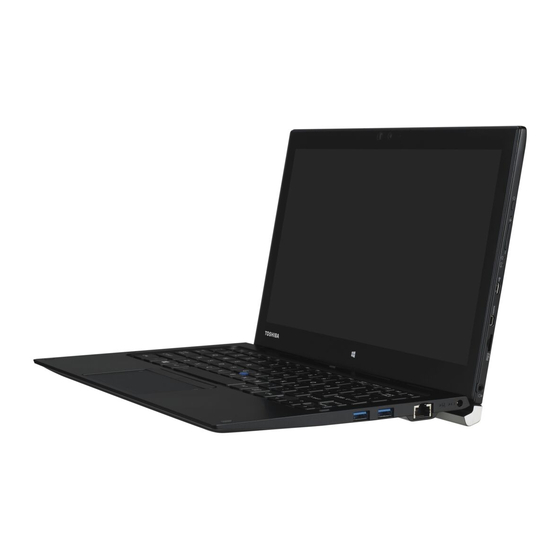
Table of Contents
Advertisement
Advertisement
Table of Contents

Summarization of Contents
Chapter 1 Legal, Regulatory, and Safety
Copyright, Disclaimer and Trademarks
Covers copyright information, disclaimers on manual accuracy, and trademark acknowledgments.
Regulatory Information
Details regulatory compliance, including FCC and EU declarations.
General Precautions
Provides essential safety guidelines for using the computer.
Provide adequate ventilation
Ensures proper airflow to prevent overheating and damage.
Creating a computer-friendly environment
Tips for setting up a workspace to protect the computer.
Stress injury
Information on preventing discomfort from computer use.
Heat injury
Precautions regarding potential heat-related issues.
Cleaning the computer
Instructions for maintaining the computer's cleanliness.
Moving the computer
Guidance on safely transporting the computer.
Chapter 2 Getting Started
Equipment checklist
Lists all items included with the computer.
TOSHIBA Keyboard Dock
Details about the keyboard dock accessory.
Using your computer for the first time
Basic steps for initial computer setup and operation.
Connecting the AC adaptor
Instructions on how to connect the power adapter.
Turning on the power
Procedure for powering on the computer.
Turning off the power
Methods for safely shutting down the computer.
Sleep Mode
Information on entering and using Sleep Mode.
Hibernation Mode
Details on using Hibernation Mode for power saving.
System Recovery
Procedures for recovering the system.
Chapter 3 The Grand Tour
Tablet computer
Overview of the tablet computer and its components.
Display screen
Details about the tablet's LCD display.
Power button
Information on the computer's power button.
USB Type-C (USB3.1 Gen1) port
Description of the USB Type-C port.
HDMI™ Micro port
Details about the HDMI™ Micro port.
Memory media slot
Information on the memory card slot.
TOSHIBA Keyboard Dock
Overview of the keyboard dock and its features.
Front view
Highlights the front-facing components of the keyboard dock.
Internal Hardware Components
Description of internal hardware like CPU and storage.
Battery pack
Details about the computer's internal battery pack.
CPU
Information on the Central Processing Unit.
Internal storage
Details on the computer's internal storage capacity.
Power Condition Descriptions
Explanation of power and battery status indicators.
Battery indicator
Describes the meaning of the battery indicator lights.
Power indicator
Explains the status indicated by the power light.
Chapter 4 Operating Basics
Operating in tablet mode (also for WT20-C)
How to operate the computer in tablet mode.
Changing the screen orientation
How to change screen orientation in tablet mode.
Using the Touch Screen
Instructions for interacting with the touch screen.
Using the Touch Pad
How to use the computer's touch pad and gestures.
TOSHIBA Pointing Device
Details about the AccuPoint pointing device.
The Keyboard
Information on keyboard layout, keys, and indicators.
Function Key
Explanation of function key combinations.
Battery
Information on battery usage, charging, and care.
Charging the battery pack
Step-by-step guide to charging the battery pack.
Monitoring battery pack capacity
How to check the remaining battery power.
Maximizing battery operating time
Tips to extend the computer's battery life.
LAN
Instructions for connecting to a Local Area Network.
Connecting the LAN cable
Procedure for connecting the LAN cable.
Memory media
Information about using memory cards and slots.
External Display
How to connect and use external displays.
Security lock
How to connect and use a security lock cable.
Sound System and Video mode
Controls for audio and video settings.
Volume Mixer
Utility for adjusting audio volume levels.
Chapter 5 Utilities and Advanced Usage
Utilities and Applications
Overview of pre-installed software utilities.
TOSHIBA HWSetup
Utility for customizing hardware settings.
TOSHIBA PC Diagnostic Tool
Tool for checking system configuration and hardware.
TOSHIBA eco Utility
Utility for managing power consumption and eco-mode.
Special features
Description of unique and advanced computer features.
Display automatic power off *1
Feature to automatically turn off the display.
Sleep Mode
Information on Sleep Mode functionality.
TOSHIBA Password Utility
Utility for setting user and supervisor passwords.
Supervisor Password
Details on setting and managing supervisor passwords.
TOSHIBA HWSetup
Accessing and using the BIOS setup utility.
Using the TOSHIBA Sleep Utility
How to change Sleep and Charge settings.
Chapter 6 Troubleshooting
Problem-solving process
Guidelines for identifying and resolving issues.
Preliminary checklist
Basic checks to perform before troubleshooting.
Analyzing the problem
Steps to diagnose the cause of a problem.
If something goes wrong
Troubleshooting common computer malfunctions.
Your computer does not respond to the keyboard commands
Solutions for keyboard input issues.
The computer does not start
Steps to resolve power-on issues.
Hardware and system checklist
Checklist for hardware and peripheral problems.
Power
Troubleshooting power-related issues.
Overheating power down
Resolving issues related to computer shutdown due to overheating.
BIOS
Troubleshooting issues related to the BIOS.
Keyboard
Troubleshooting keyboard problems.
Touch Pad
Resolving issues with the touch pad.
Sound system
Troubleshooting audio output and input problems.
External monitor
Resolving problems with external display connections.
TOSHIBA support
Contacting TOSHIBA for technical assistance.
Chapter 7 Appendix
Specifications
Summarizes technical specifications of the computer.
Physical Dimensions
Provides the physical dimensions of the computer.
Power Requirements
Details the AC adapter voltage and frequency.
Information for Wireless Devices
Information on wireless technology interoperability.
Wireless Devices and your health
Information on radio frequency emissions and health.
Disable the AMT function
Instructions to disable Intel® Active Management Technology.
Legal Footnotes
Provides legal information and footnotes.
CPU
Legal footnotes regarding CPU performance.
Memory (Main System)
Details on system memory usage and limitations.
Battery Life
Information regarding battery performance and lifespan.
















Need help?
Do you have a question about the Satellite Pro Z20t-C Series and is the answer not in the manual?
Questions and answers